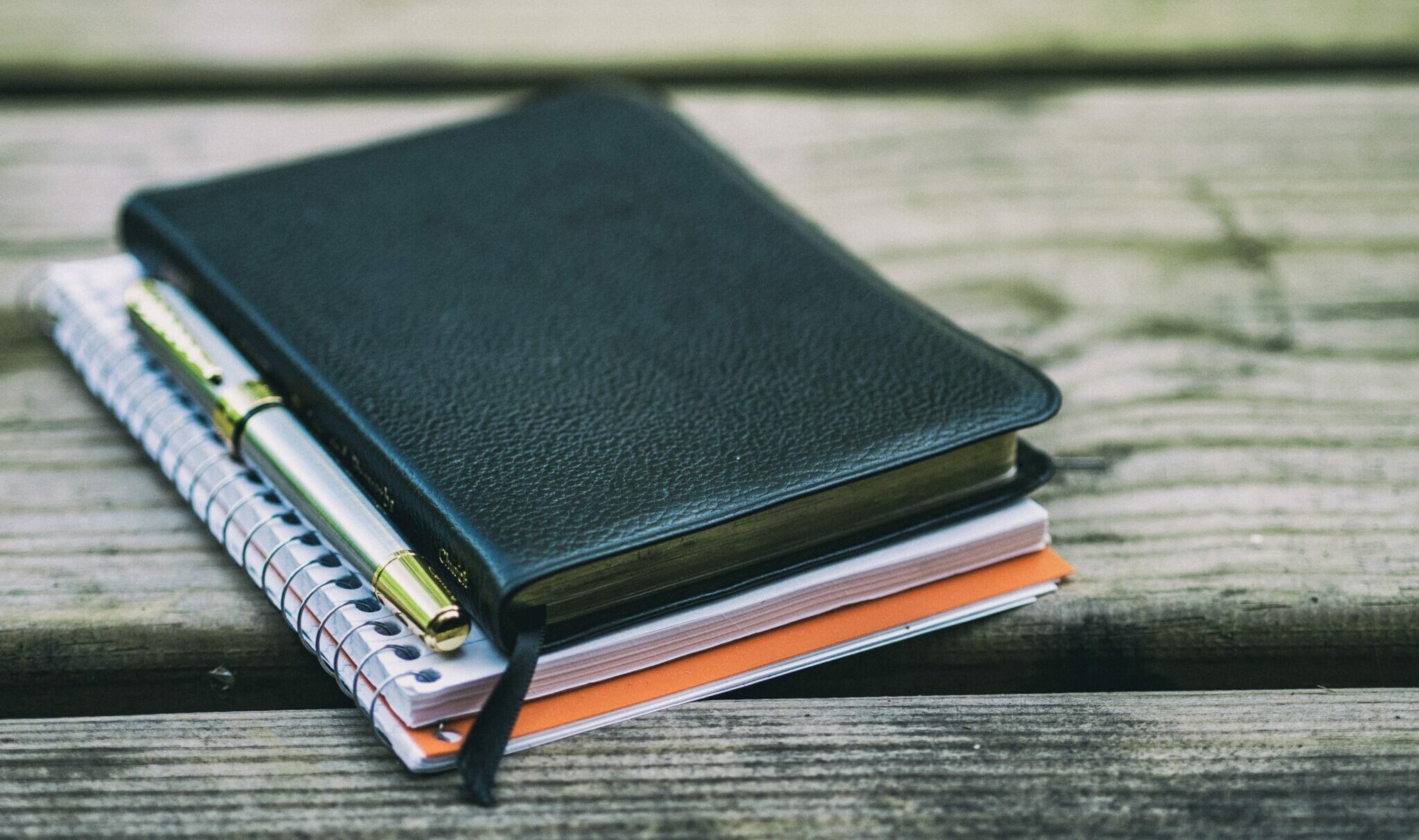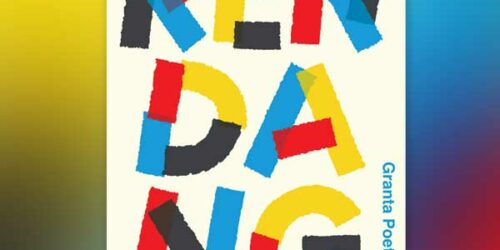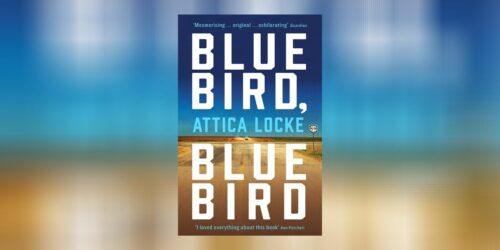
Over September and October our (virtual) NCW Book Club is RENDANG by Will Harris. We hope you’ll join us in reading the book and joining the conversation – find out more here about all the ways that you can get involved.
RENDANG is notable for the variety of poetic forms that Will Harris uses to explore themes including human connection, public space and family histories. Each different form allows Harris to explore a different facet of these issues, mixing anecdote, humour and even philosophy to address them in all their complexity.
Here we share two writing exercises inspired by RENDANG that use constraint to help you open up different ways of looking at things – or perhaps even narrow your field of vision. Let us know how you get on over on our Discord community. Happy writing!
Found phrases
Throughout RENDANG Will Harris includes snatches of other voices – from passing conversations, from books, and even from dreams. Including these allows him to look at other perspectives even within the constraints of a short poetic form, and is a key way in which we get the sense of encounter between people that gives the collection such energy.
This exercise looks at one way to gather and use similar material in your own writing. You can do this exercise over an afternoon, a couple of days, a week, or even more if you like!
To start with we’ll need to gather some voices to use. A writer’s notebook or similar that you can have to hand throughout this exercise will come in useful here. Make sure you have the notebook to hand with you wherever you go for the duration. Start by noting down very quickly phrases that you come across over this period. These might be from the radio or TV, overheard in the supermarket queue, or from a Skype or phone call with family or friends. Make notes as soon as you can after hearing the phrase. It doesn’t matter whether you get every word down perfectly, but shorter phrases will be easier to use. The phrases can be on any subject and you can collect as many of them as you like, though ten can be a useful minimum. Keep a note of where you heard each phrase, too.
Once you’re happy with your collection of phrases, it’s time to organise them. You might like to type them up or rewrite them onto a fresh page, so that they’re clearly discernible and you can begin to chop and change them more easily. Begin to organise the phrases into small groups according to their common features. Do you have phrases that are about the same or similar topics? Do any words recur across different sources? You might have a small group of questions, or phrases in the first person. Do any of them share a tone or register (informal/formal, instructive/questioning, everyday/scientific, etc.)?
Once you have a series of small groups of phrases, choose a group to work with for now. Write out each of these phrases again, with a line in between them. It may help to italicise them, or to write them out in a different coloured pen. Look again at their shared features – how would you describe this group in terms of mood, register, syntax, word choice? Make a quick note of these features at the top of your page as a reminder.
Now it’s time to try and fill in the gaps between these phrases, linking them into a single paragraph. Don’t pressure yourself to make complete sense or even sentences to start with – simply find connections between the phrases, and write them down, following where these ideas may take you.
Once you have linked all the phrases together, it’s time to edit. You can shape this paragraph into a prose piece with full sentences, or consider the best places for line breaks as you start to build a poem. Crucially, try not to change the words of your gathered phrases, but rather let them stay as they are. Work on your own words around them to tidy up the piece as you wish.
As you continue to draft, read the piece back to yourself, both silently and aloud. Does the new piece retain the mood/ register/ syntax/ word-choice/ etc. of your group of source phrases? How would you describe the features of the new piece? What are the similarities and differences between it and the source group, and what is the effect of this? Are you happy with these similarities/differences, or could you edit the piece to move closer to or further from the original?
When you’re reasonably happy with the piece, experiment with how you present the found phrases. Will Harris keeps the other voices in his poems italicised, differentiating them from the rest of the poem, and cites some of the found phrases in the acknowledgements at the back of the book. What would work best for your piece? What is the effect of changing the formatting so that the found phrases are visually distinct, or are absorbed into the body of the text? Does it depend on the context of where you found the phrase? Do you need to acknowledge any sources, and which would be the best way to do so? Decide on the best way forward for you and your particular source material.
Journey with a refrain
This exercise is similar to the one above, but this time we’ll be working repeatedly with one found phrase, exploring how the same words can change in tone, association and meaning each time they are spoken.
Throughout the book Will Harris repeats certain words and phrases, each time finding a new angle on them – think about the word bamboo in ‘Another Life’, the opening concrete poem, and even the word break in its eponymous poem. A refrain takes this to an extreme, and is a repeated line that recurs throughout a piece of writing. ‘Buddleia Not Buddha’ is a prime example from RENDANG, repeating the line buddleia not buddha chanting in bloom’, and will form the basis of this exercise.
While refrains are most often used in poetry, there’s no reason that you couldn’t try this exercise to create a prose piece, too.
Choose one of your found phrases that interests and appeals to you. This will be your refrain. Now, double check where you found this phrase. This location is going to determine the journey of the piece. If you’ve chosen something from radio, tv or a book, then you’ll need to get creative, considering the journey through the radio waves, via satellite, or from the warehouse to your bookshelf!
Write your refrain three or four times on the page, leaving several lines between each one.
In the lines between your refrain, write about the journey you have taken or imagined in finding the found phrase. For example, if you overheard it in a supermarket queue, recount your journey round the supermarket. You might include concrete details of the journey, the inner journey of thoughts or feelings, and/or those associations that come up for you now as your retrace your steps in writing.
Once you’ve reached the final refrain, repeat your found phrase to bring the poem to a close. If you need to, you could introduce a small change to the refrain to indicate an ending. Will Harris does this, bringing ‘Buddleia Not Buddha’ to a neat finish with a rhyming couplet. Have a go.
Read back over what you’ve written. Try reading the piece aloud. How does the refrain change each time you repeat it? Does the energy or vitality of the words change as the poem progresses? How does it relate to the journey? Has the refrain influenced the way you’ve written the other lines? You might like to try paying particular attention to the moments of ease and difficulty in your journey – does the rhythm of your piece reflect these moments?
Now it’s time to edit as you see fit. Be playful, and don’t be afraid to make changes – just keep your refrain as it is. What happens if you space the lines of the refrain out further, adding more lines in, or bringing them closer together, adding in more repetitions of the refrain? Does this alter the journey, too? Keep going until you have a piece that you’re happy with.
Choose a title for your piece – will you use the refrain as the title, or something else? Why/ why not?
Both of these exercises require us to work within a formal constraint. Some writers find that constraint opens up different ways of looking at things, and others find it narrows the field. Feel free to tweak these exercises to suit your writing preferences, time available, and chosen genre. You could even try the same exercise twice, the first time following the instructions, and the second putting your own spin on them. Notice how you feel each time. How did you relate to these constraints? What decisions and deviations did you make while trying the exercises out? You might like to write a brief reflection in your writer’s notebook about your experiences of writing within a constraint.
You may also like...
RENDANG – questions for readers
Will Harris’ ‘heart-stopping’ first full poetry collection is our current NCW Virtual Book Club pick

13th October 2020
Book Club: RENDANG by Will Harris
Flo Reynolds introduces our latest Book Club read

17th September 2020
Book Club: Bluebird, Bluebird by Attica Locke
Flo Reynolds launches the new Book Club book!

2nd July 2020






